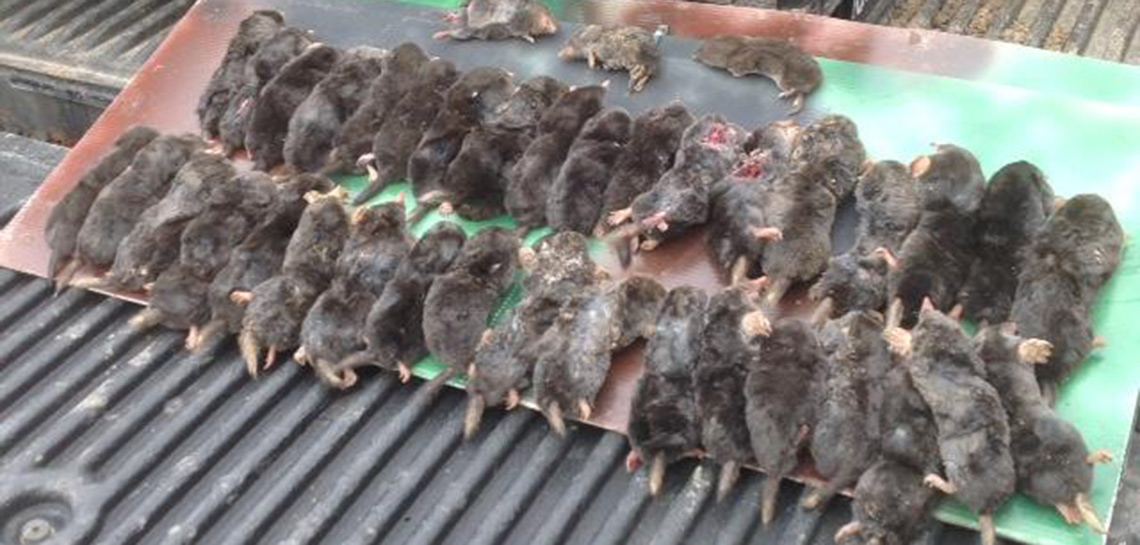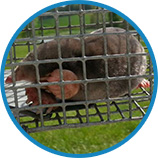Mole Removal - How to Get Rid of Moles
Moles - Problems They Cause, Methods of Removal and Prevention: Moles are mammals who have adapted to live underground. As such, they will dig complex networks of tunnels through which they can reach their favorite foods: earthworms and other insects. They are carnivores, so they won't forage after vegetation. They are most active during the wet seasons, so you should expect more activity from them during spring and autumn. This is because wet soil that is easy to dig through is a lot more appealing to them than clay-filled soil.

Problems moles cause
As mentioned above, the main method of getting around of your garden variety mole is digging complex tunnel networks. Some of these will likely go unnoticed, as they are dug deep underground and serve as the main tunnels. From these, the mole will dig other, smaller tunnels in search of food – these tunnels will not be used regularly. The problem is that if they dig such tunnels under lawns and near the surface, rainfall or weight can make the ground collapse along the tunnel's length, leaving unsightly ridges in your front lawn.
Aside from that, moles often will dig through to the surface, creating those volcano-shaped molehills, and turning out significant quantities of dirt outside. This dirt can stain a perfectly green lawn, and can destroy nearby vegetation that may get suffocated by it. The tunnels underneath can also impact vegetation negatively due to roots being damaged or plants being uprooted altogether.
Given that moles usually forage for earthworms, and that they find them near or around gardens where the soil is also moist and rather loose, making it easier for the mole to move around underground, backyard gardens are exposed to mole damage risks. While the mole will not eat the vegetation, it will kill a lot of plants in the process of its foraging for food, and depleting the earthworm population can have negative consequences for plant life as well. Earthworms not only aerate the soil, but they actually create soil by eating and digesting vegetation. They also produce and distribute a lot of nutrients which plants need to properly thrive – a drop in earthworm population, especially in areas where gardening is already problematic due to acidic soils, for example, can really put a damper to your gardening efforts.
Last, but not least, and arguably one of the biggest problems moles can and will cause is to irrigation systems. Whether installed for your own lawn at home, or installed on a commercial space like a golf resort, irrigation systems are rather expensive to set up, and equally expensive to maintain and repair if something goes wrong. Mole tunnels often cross paths with underground irrigation installations, and the moles are likely to dislodge them and break them, which requires immediate repairs to prevent water waste and destroyed lawns due to lack of proper irrigation. This is especially problematic where irrigation is done automatically and there's little to no supervision, like if you were away on vacation.
A few other problems moles can cause are tied to agriculture. From diminishing the available land for farming by creating the molehills, to turning out rocks which can damage farming equipment, to simply destroying root networks, moles can have a negative impact on mass farming practices as well.
Methods of removal and prevention.
Removing moles is never easy. And I'm not even going to talk about live trapping and relocation, in case you were looking for this type of approach. The humane method when it comes to mole removal is catching them with lethal traps. Most other methods involve poisons, or brutally stabbing the creature when it's near the surface. These are all gruesome, unnecessary methods of dealing with an otherwise harmless creature. However, getting rid of moles can be tricky, as they live underground and seldom come up to the surface where they're exposed to potential predators. And I know it's unfortunate, but there is no other effective way of getting rid of invasive moles other than by lethal trapping. You can use a spear trap, a scissor trap or a paper clip trap, but properly setting one of these types of traps can prove to be a very difficult task for the untrained hand – and for the untrained eye, as knowing exactly where to set the trap is paramount in successfully removing this master digger. A wildlife removal professional can definitely lend a helping hand with removing the moles from your property. If possible, avoid pest control services, because they're usually inclined to do more harm than good, to both the mole and the environment.
Prevention methods are rather scarce, as moles can travel pretty deep underground, so fencing, even buried significantly, won't usually keep them at bay. However, making sure that the ground is not heavily irrigated, and that insect and worm populations are kept in check may deter the mole from paying your home a visit.
If you encounter moles or see signs like molehills or surface tunnels around your home, call a wildlife removal specialist. They'll deal with the situation in an efficient manner, not causing the animal or the environment any harm. You'll get rid of this potential pest, and will also get tips and guidance of avoiding infestations in the future. Furthermore, you'll be assisted in fixing any damage the mole may have caused while it was on your property. When making first contact with your chosen wildlife control specialist, make sure you discuss their methods before making any other arrangements. Ask as many questions as you need to – that's what we're here for (that and solving any and all nuisance wildlife problems you might have, of course).


